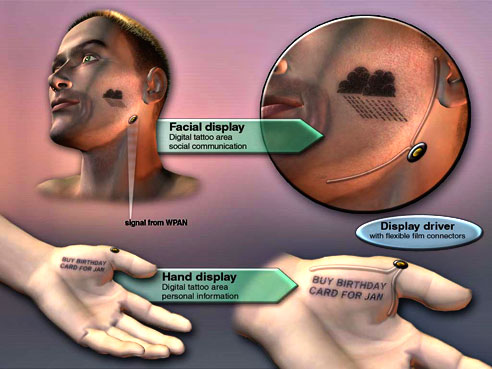Programmable Tattoos

Programmable tattoo applique with emoticons and messages.
©2003 Greg Daigle and Steve Campbell
Interesting applications for eink matrix:
Finally, a technique for modifying subcutaneous tattoos using special inks has also been patented. It relies upon microencapsulated spheres injected under the skin. Such microencapsulation is typified by eInk's "digital ink" technology for use in electronic paper. A set of drive electrodes manually applied to the skin manipulates the tattoo image electrically.
A preferable design would be for programmable tattoos that were both continuously dynamic and tied into digital data displays. And if we could only avoid the needle!
Inventor Andrew Singer, working for Paul Allen's Interval Research Corporation, had a similar medical application in mind in his 1997 patent for a "programmable subcutaneous visible implant." Also a display chip, it was designed to be implanted just under the skin and display bio-sensing readouts monitoring medical conditions such as diabetes -- though sans nanorobots. The device was designed to save precious time in an emergency.
For under-the-skin implants, the thinner and more flexible the better. A "nano-skin" polymer film was recently shown by scientists at Rensselaer Polytechnic Institute (RPI). This flexible polymer infused with billions of carbon nanotubes is seen as making possible incredibly thin and flexible displays. Nanotubes are excellent electrical conductors and several research organizations are exploring their use in flexible screen displays.
In a speculative design that first appeared in Popular Science, tattoos are applied to the skin surface in three successive applications of a breathable cyanoacrylate film matrix similar to Liquid Bandage. First a matrix with conductive microrods is applied. Then a powered pad that aligns the microrods with an electromagnetic field is placed over the skin for a minute until the matrix is dry. This is followed by the application of a layer of digital ink matrix followed by another layer of conductive microrod matrix aligned at right angles to the first.
The WPAN server uses wireless technology such as Bluetooth or UWB (ultra-wide band) to connect the components. But Korean firm KAIST reported this year the use of WPAN chips to achieve data rates of up to 2 megabits a second by sending data signals through the body itself rather than using either Bluetooth or other radio technologies.
via OhMyNews

0 Comments:
Post a Comment
<< Home